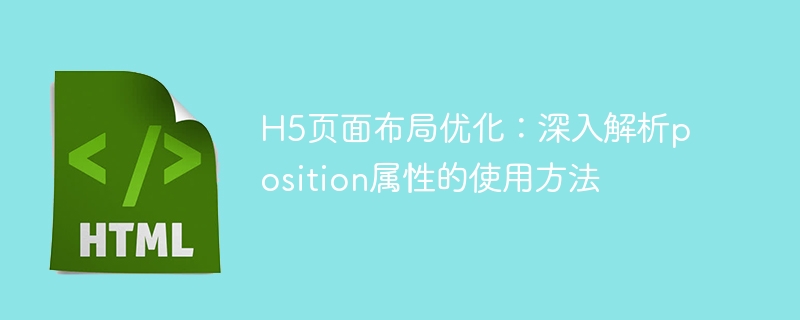
H5 page layout optimization: in-depth analysis of how to use the position attribute
In H5 page development, layout optimization is a very important part. Among them, the position attribute is one of the important attributes that controls the positioning of elements. This article will provide an in-depth analysis of how to use the position attribute and provide specific code examples to help readers better understand and apply it in actual development.
1. The basic concept of position attribute
The position attribute is used to control the positioning method of elements. It has the following values:
- static: Default value, elements are arranged according to the HTML document flow and are not affected by other positioning attributes.
- relative: relative positioning, the element is positioned relative to its normal position. It can be fine-tuned through the top, right, bottom, and left properties.
- Absolute: Absolute positioning, the element is positioned relative to its nearest positioned parent element. If there is no positioned parent element, positioning is based on the html element.
- fixed: fixed positioning, the element is positioned relative to the browser window and does not change position as the scroll bar scrolls.
- sticky: Sticky positioning, the element will be fixed on the screen when specified conditions are met. Commonly used conditions include top, right, bottom, and left attributes.
2. How to use the position attribute and code examples
- Relative positioning: relative
Relative positioning is often used to fine-tune the position of elements and will not affect the position of other elements. layout. The code example is as follows:
- Absolute positioning: absolute
Absolute positioning is often used to implement overlapping layout or centered alignment of elements. The code example is as follows:
- Fixed positioning: fixed
Fixed positioning is often used to implement functions such as floating the navigation bar or returning to the top. The code example is as follows:
- Sticky positioning: sticky
Sticky positioning is often used to fix elements on the screen when scrolling to a certain position. The code example is as follows:
3. Summary
This article details the use of the position attribute and code examples. By flexibly using different position attribute values, various complex layout effects can be achieved, thereby optimizing the display effect of the H5 page. Readers can choose the appropriate positioning method based on actual needs and combine it with other layout techniques to create a better web page layout.
The above is the detailed content of In-depth understanding of the application of position attribute in H5 page layout optimization. For more information, please follow other related articles on the PHP Chinese website!






